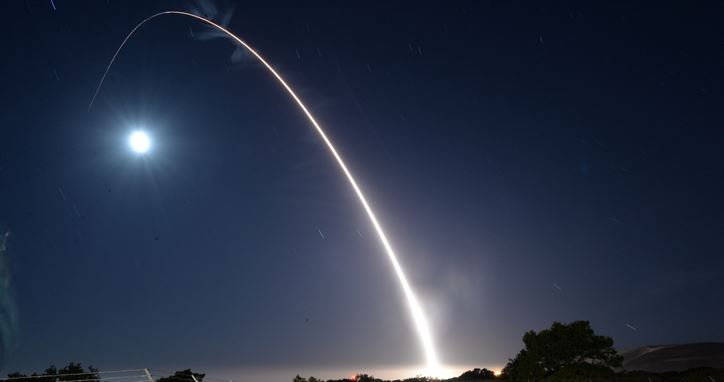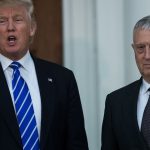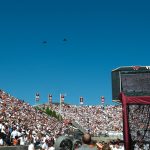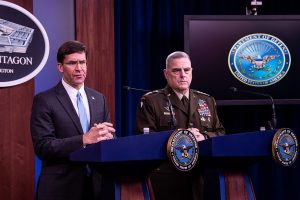by Joe Cirincione
When I went on the Rachel Maddow Show on Friday, I expected to talk about the Iran nuclear accord, about the speech that President Trump had given that day. But Rachel Maddow wanted to talk about missile defense.
She’s afraid that Trump will go to war with Iran or North Korea in the mistaken belief that the United States has missile defense systems that can actually protect our allies and our nation. This may be why he believes he can freely taunt North Korea. Even if North Korea shot a nuclear-armed missile at the United States, “Maybe he thinks that it would be super-easy to shoot it down, that it is not even really a risk,” she said.
This is an appeal to critics and supporters of missile defense to explain—in their own way and in their own time—that we do not have such a near-perfect defense system. The United States cannot reliably shoot down enemy missiles. At best, this country has a system that can shoot down some of the missiles, some of the time.
If the president acts on his impression, he might start a war that nobody wants.
When I discussed this with Maddow, she shared a clip of Trump discussing missile defense: “The percentage of success is so high, it’s so brilliant what we can do what we have to do to have a safe country.” She also ran a clip from his October 11 interview with Sean Hannity: “We have missiles that can knock out a missile in the air 97 percent of the time, and if you send two of them, it’s going to get knocked down.”
No, we don’t. The president is mangling a 2011 quote from a missile defense advocate, as Glenn Kessler of The Washington Post explained in his Fact Checker article. Kessler assesses the accuracy of Trump’s statements at “four Pinocchios,” meaning that they amount to a “whopper” of factual errors. Furthermore, “several experts said the high-90s claim appears to be based on faulty math.” As Carnegie Endowment senior associate James Acton told Kessler, the claim is that if our interceptors perform at a 50 percent success rate (based on the Ground-Based Interceptor hitting the target in 10 of its 18 tests since 1999), then four interceptors would have a high chance of intercepting an enemy missile, not one.
And even that math is bad. “I think this reasoning is flawed,” Acton says. “It assumes that the failure modes of the interceptors are independent of one another. But, in practice, if one interceptor fails because of a design flaw, say, it’s much more likely that others will do so too for the same reason.”
According to investigative reporting by David Willman of The Los Angeles Times, almost one-third of the interceptors based in Alaska and California have two design flaws that could ensure their failure. All of the deployed interceptors have one of these flaws. The results, concludes the Government Accountability Office, would be “failure modes” resulting in “an interceptor fleet that may not work as intended.”
“I think the answer is absolutely clear: It will not work,” Rep. John Garamendi (D-CA) told The Los Angeles Times. “Nevertheless, the momentum of the fear, the momentum of the investments, the momentum of the industry—it carries forward.”
I appeal to all my colleagues who vigorously support the missile defense program, who want more missile defenses deployed, who believe that an effective missile defense system is just around the corner, to join me in publicly cautioning the president that this is, at best, an imperfect system. It cannot provide a reliable defense. The president must not commit American troops to battle believing that the United States can knock down an enemy missile aimed at South Korea, Japan, or the U.S. mainland.
“The confidence with which [Trump] made the statement indicates a lack of understanding of the complexities or perhaps a lack of interest in those complexities,” says Alexandra Bell, senior policy director at the Center for Arms Control and Non-Proliferation.
And here is where the story gets worse. The above statistics are based on the erroneous belief that the test results are an indicator of real-world performance. They are not.
Each of the tests is carefully scripted to ensure success. To “hit a bullet with a bullet” is a major technological achievement. But the only way to hit a bullet is if the bullet cooperates.
Each test minimizes any variables that can reduce the chance of success. The tests are done in the daylight, in clear weather. They are done without any effort to hide the warhead within a cloud of realistic decoys or chaff or jammers. The tests assume that the enemy won’t attack radars and blind the interceptors. In short, in the over 50 years and over $330 billion dollars spent on dozens of missile defense programs, the United States never conducted a realistic interceptor test that tried to duplicate actual combat conditions.
North Korea would not cooperate if it fired a missile at the United States or its allies. Iran would not cooperate in a war where it fired a short- or medium-range missile in the region. North Korea would certainly have decoys and other countermeasures, as the 1999 intelligence estimate on the ballistic missile threat assessed that they would. Iran would certainly shoot a volley of missiles to overwhelm defenses that have never been tested against more than two targets.
I investigated anti-missile programs for almost 10 years as professional staff on the House Armed Services and Government Operations Committees. If people took a close look at just one of these interceptor tests, they would likely conclude, as I did, that the tests bear little resemblance to real-world conditions.
I ask my colleagues who are more expert than I am to help explain this and to warn policymakers and the public about the risks of committing to war believing that the United States can defeat an enemy’s counter-strike.
Rachel Maddow got that. She is listening. She is worried about the connection between Trump’s false confidence in defenses and a decision to launch an offensive war. “Do you believe,” she asks, “if he has got that kind of specific misunderstanding, do you believe that maybe [that is] one of the things that is undergirding…the kind of decisions he has made on nuclear policy both around North Korea but also this Iran deal announcement today?”
Yes, it is. Now would be a good time to talk about the hard, brutal realities of missile defense.
Joe Cirincione is the president of Ploughshares Fund and the author of Nuclear Nightmares: Securing the World Before It Is Too Late.






The notion of Iran as a “threat” to the US is rubbish.
Thanks for that important post , I do agree , that the general assumption , must be , that in real terms or real conditions , things may change or vary , resulting so finally in failure . Yet , worth to note :
Such system of anti missile has been already launched in eastern Europe ,and according to the Pentagon , designated for interception of Iranian missiles ( I think that finally abandoned partly at least ) . One may read here :
” U.S. launches long-awaited European missile defense shield
By Ryan Browne, CNN ”
Also , the Navy , already in 2008 , has taken down , a satellite ( dying one ) through such missile , one may read here ( CNN ) :
” Navy missile hits dying spy satellite, says Pentagon ”
So , not to get the false impression , that it is the hobby , or personal caprice of Trump of course . He doesn’t seek any war , it is not because of the existence of such system , that he has offensive plans against North Korea . The US has issues with North Korea , notwithstanding any anti missile system , so finally better with it , over without it anyway .
Finally , also worth to note , that the Israelis , has reached very high percentage of success , in intercepting even more complicated targets with the ” Iron dome ” system , taking down very short range rockets .Yet , the ” Arrow 3 ” designed for taking down , outside the atmosphere nuclear missiles ( like the American the post subject ) has been proven to be efficient in real terms ( above Syria , taking down a surface-to-air missile fired from there ) here one may read ( Fox news ) :
” Israel’s Arrow anti-missile system scores first hit”
Thanks
This article is excellent, and lets us know that the “defense” the USA spends so much on is not doing a job of defending the Homeland. If course the USA could destroy North Korea or Iran after a foolish first strike that neither would be likely to risk, but the USA and/or its allies could be very seriously damaged first. I am delighted that Rachel Maddow has turned her attention from Russophobia for the moment.
The Cold War seems to have taught Trump nothing, but there were many like him in the years of the Cold War. Nobody wins a nuclear war, and the USA has no defense, only methods of attack. Chalmers Johnson pointed this out after “9/11”, when the Department of Homeland Security had to be invented.
Before North Korea learns how to mate a nuclear weapon to a survivable re-entry missle that can effectively hit America, Japan or South Korea, is the opportune time to strike.
The best defence is a good offence. Anti-missle systems will be overwhelmed if we wait for ‘Rocket Man’ to build and deploy far too many offensive missles to degend against.
Now is the time to attack & replace this country that only survives by keeping it malnourished citizens constantly preparing and planning for the threat of war.
Were the No.Korean regime a peaceful, rational opponent like Russia or China, we could reasonanly expect a lifetime of peaceful competition without grave threats, but Kim Il Jung’s regime is sure to cross boundaries to pursue its selfish national objectives.
Neutralize the threat, sooner rather than later.
Neil W. Dorian
Hastings. FL.
I’m rather surprised at how foolish all the quotes of failure percentages when including all of the previous versions of these defense missiles. Since 1999? It’s been almost 20 years and have had 3-4 upgrades since then. You can’t measure success based on anything other than the last 3 tests. Also, don’t lump all of them into the same bucket. The EKV interceptors are the worst performing. The THAAD system has been flawless in every test. The naval interceptors are now at excellent performance.
These systems are expensive. We don’t have massive batteries if some systems. And guess what, some of the test environments are CLASSIFIED! So you won’t be told how well it performs in realistic war!